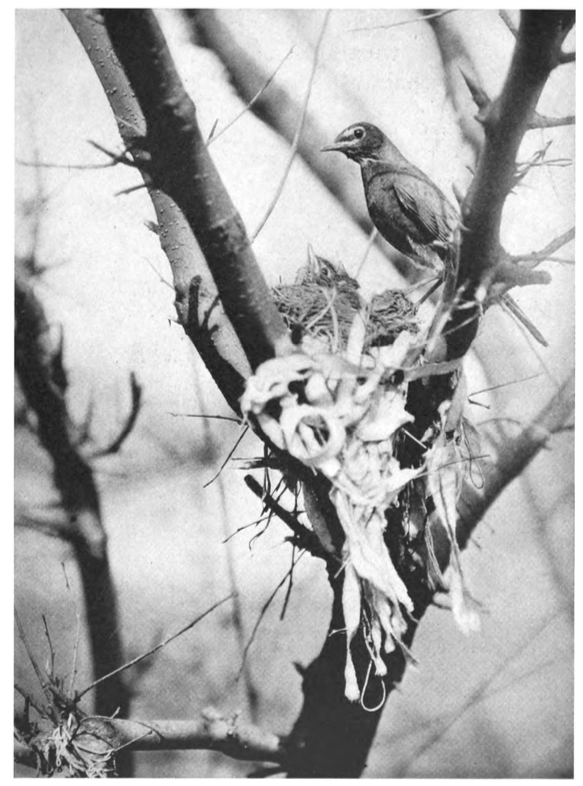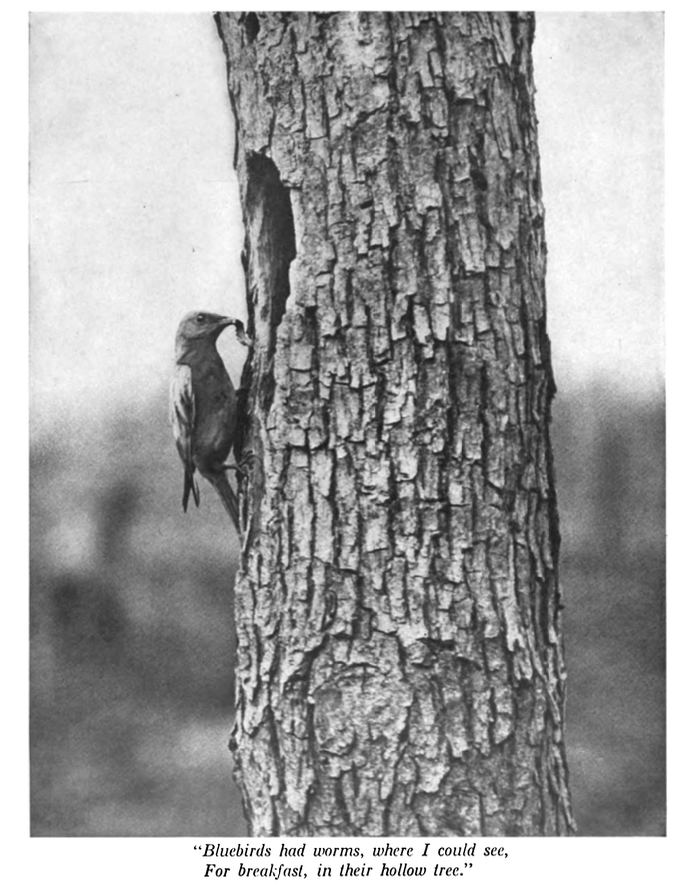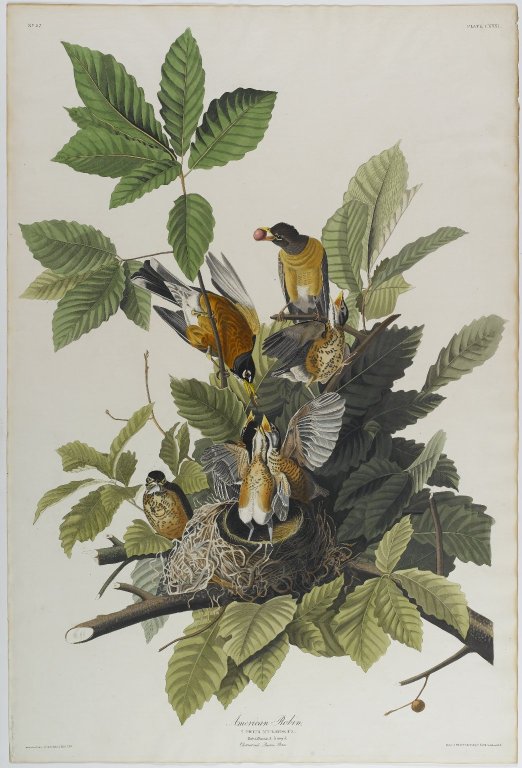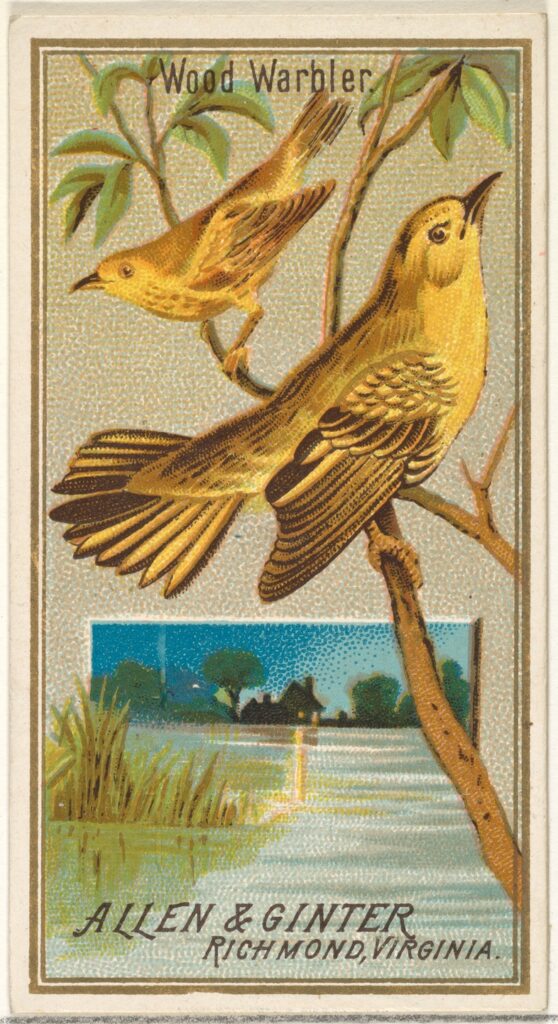Bread and Milk
By Gene Stratton-Porter
Annotations by Rene marzuk

Every morning before we eat,
My mother prays a prayer sweet.
With folded hand and low-bowed head:
“Give us this day our daily bread.”
But I’d like tarts and ginger cakes,
Puffs and pie like grandmother makes.
So ’smorning I said my appetite
Must have a cake, or ’twouldn’t eat a bite.
Then mother said: “’Fore you get through,
You’ll find just bread and milk will do.”
She always lets me think things out,
But I went to the yard to pout,
What I saw there–Upon my word!
I’m glad I’m a girl–not a bird.
Redbreast pulled up a slick fishworm,[1]
To feed her child: it ate the squirm.
Bee-bird came flying close to me,[2]
And caught a stinging honey bee.
She pushed it down her young, alive.
She must have thought him a beehive.
Old warbler searched the twigs for slugs,[3]
Rose Grosbeak took potato bugs.[4]
Missus Wren snapped up a spider,[5]
To feed her baby, close beside her.
Little Kingbirds began to squall,[6]
Their mother hurried at their call.
She choked them with dusty millers.[7]
Cuckoos ate hairy caterpillars.[8]
Blue birds had worms, where I could see,[9]
For breakfast, in their hollow tree.
Then little Heron made me squeal,
Beside our lake he ate an eel.
When young Screech Owl gulped a whole mouse,[10]
I started fast for our nice house.
Right over me–for pit-tee sake,
Home flew a hawk, with a big snake!
So ’for my tummy got awful sick,
I ran and kissed my mother quick.
I acted just as fine as silk
And asked polite for bread and milk.

STRATTON-PORTER, GENE. “BREAD AND MILK,” IN MORNING FACE, 26-7. NEW YORK: DOUBLEDAY, PAGE & COMPANY, 1916.

[1] Robin red-breast is one of the many names of the American Robin, one of the most popular backyard birds in North America. Early European settlers named the American Robin after the European Robin because of its reddish breast. However, the American Robin is actually a thrush.
[2] According to the Oxford English Dictionary, the name bee-bird can refer to either a Spotted Flycatcher or a hummingbird. Because the bird in Stratton-Porter’s poem catches a bee, we can safely assume the speaker refers to flycatchers, an heterogeneous group of migratory birds that breed in Indiana and feed on insects.

[3] North America is home to more than 53 species of warblers, small to medium-sized songbirds.
[4] Listen to the distinctive songs and calls of the Rose-breasted Grosbeak. The potato bug, or Colorado potato beetle, is considered a pest of potato, eggplant, tomato, and pepper plants.
[5] A comprehensive resource on North American wrens.
[6] Listen to the distinctive songs and calls of the Eastern Kingbird.
[7] The speaker is probably referring to miller moths, a generic name for moths, mainly army cutworms, which proliferate around homes. Coincidentally, the dusty miller (known as silver dust or silver ragwort as well), is also a perennial plant that is popular with gardeners because of its striking silvery leaves.
[8] Overview of the Black-billed Cuckoo, the most common of the three types living in North America–the others are the Yellow-billed Cuckoo and the Mangrove Cuckoo.
[9] A guide to the Eastern Bluebird, courtesy of the Audubon Society.
[10] In addition to mammals like rats, mice, squirrels, moles, and rabbits, the Eastern screech-owl also feeds on insects, invertebrates, amphibians, reptiles, and other birds.
Contexts
In her introduction to the 1996 anthology Coming Through the Swamp: The Nature Writings of Gene Stratton Porter, Sydney Landon Plum reveals that, after the commercial success of Gene Stratton-Porter’s 1909 novel A Girl of the Limberlost, the author and conservationist talked Doubleday, Page & Company into publishing once nature work for each of her subsequent novels. Morning Face, a collection of prose and poems published by Doubleday in 1916, probably saw the light as a result of this agreement. Most of the book’s illustrations are photographs by the author herself, an accomplished self-taught photographer. In fact, according to Plum, Stratton Porter “ardently supported the use of photography for nature study as a substitute for the common practice of killing scores of the natural subjects in order to study them.” As evident in the quatrain that serves as the dedication of Morning Face, Stratton-Porter had a juvenile audience in mind for this book, although one can also make the case that, by identifying herself with the “little girl with a face of morning,” she is also extending her appeal to the inner children within readers of all ages:
One little girl with a face of morning, a wondering smile her lips adorning, wishes her pictures and stories to share, so she sends them to children, everywhere.
Resources for Further Study
- Kathryn Aalto’s “The Legend of Limberlost,” available through the Smithsonian Magazine‘s website, offers a portrait of Stratton-Porter that emphasizes her love of nature and her conservationist efforts.
- Gene Stratton-Porter’s Cabin at Wildflower Woods is a museum open to the public in Rome City, Indiana. Stratton-Porter designed the cabin, which was completed in 1914 and sits on 148 acres of fields, woods, and gardens.
- An extensive list of Indiana’s bird species. Stratton-Porter lived most of her life in this state.
- Enjoy this 1915 brief recording of Charles C. Gorst’s impressive imitations of the songs and calls of American birds, including the American Robin, the bluebird, and the cuckoo, which Stratton-Porter includes in her poem.